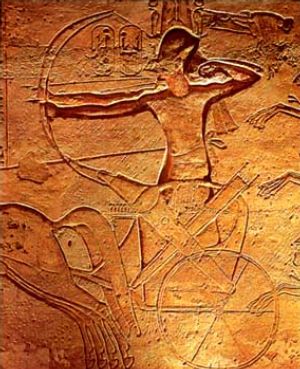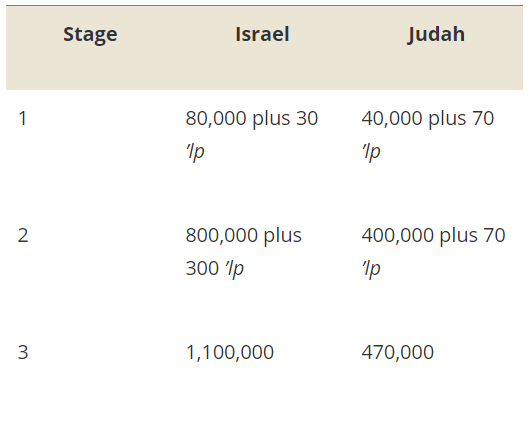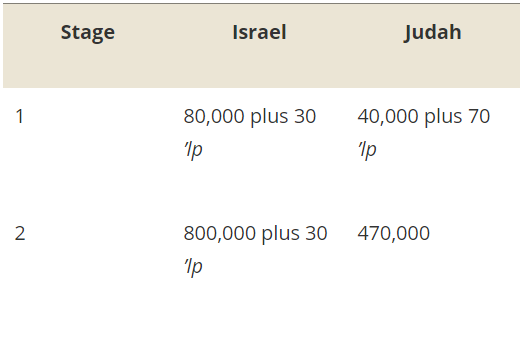There are all kinds of problems with the Old Testament if you are looking for this text to behave like a history book. To me, the narratives in this text are not always to be read literally, nor are they written for the Western mind’s perspective on story telling. The way we in the 21st century understand history is totally foreign to the writers of the Old Testament!
In the words of Bernard Batto:
P (the priestly writer) would have had difficulty understanding our modern concern over whether there literally existed a paradisiacal divine garden or whether God actually created humankind by modeling a clay anthropoid figure into whose nostrils God blew the breath of life, or similar questions. His ability to pose other, even new, ways of looking at creation shows that he understood that one is dealing here with something other than historical literalism. But that did not make such stories less true. The notion that something is true only if it is historically accurate is a prejudice we moderns inherited from our Enlightenment mentors. For P these primeval stories were vehicles that enabled one better to approach the mysterium tremendum of the divine. 1
Some problems with the Exodus narrative
 Exodus 12:37 describes the Israelites as “about six hundred thousand…that were men…and a mixed multitude….” That number suggests a total population of 2-3 million, right around the population of Utah in 2016 (about 3 million).
Exodus 12:37 describes the Israelites as “about six hundred thousand…that were men…and a mixed multitude….” That number suggests a total population of 2-3 million, right around the population of Utah in 2016 (about 3 million).
On their march out of Egypt, 2-3 million people would produce a row of 35 across and a column of over 60 miles long if people walked at intervals of less than six feet. The time lapse from the first man stepping off until the last man would move would be about 2-8 days. If you have ever run a marathon, you know how large numbers of people can hold things up! Just getting to the starting line can be quite the accomplishment!
It’s pretty tough to walk close together over rough terrain, so the real column length would more likely be about 100 miles long. This kind of group and sheer mass of people presents specific challenges that are unique to this text. Exodus 14:1-3 describes these people circling back to face their enemies. How could such a large group of 2-3 million people turn around in such a small area?

The passing through the Red Sea on dry ground overnight would have been an impossibility for 3 million people as this passage would have required days to accomplish (see Exodus 14:20-24).
Another textual challenge with 2-3 million Israelites leaving Egypt in Exodus has to do with the fear they are experiencing as they leave. 600 chariots are probably not going to pose a serious threat to 600,000 men. So that is another problem I see with the numbers in this text as we have it (see Exodus 14:7-11).
Another difficulty that is hard to resolve in the book of Exodus has to do with the logistics required to supply feed, water and move such a large number of people. According to one author, it would take 1,500 tons of food, 4,000 tons of wood as fuel and 11,000,000 gallons of water each day to supply the basic needs of this group. Another problem is the location of the latrine. Just relieving yourself would be a logistical accomplishment! 2

One of several problemss expressed about the very large number of Israelites mentioned in the account of Exodus and Numbers is that with a fighting force of more than 600,000 men, the Israelite army would have been the largest army in the Ancient Near East by a factor of 20! The Hittites, for example, one of the Ancient Near Eastern powers during the thirteenth century B.C.E., fought the Egyptian army to a near draw at the Battle of Qadesh in Syria in 1274 B.C.E. This Hittite force numbered about 40,000 foot soldiers. The estimates for the Egyptian army at this time come in around 25,000, something much smaller than the supposed force of 600,000 Israelites about this same time in history.
How to answer some of these critical questions about the numbers
Note: From this point on, this article is quoting material straight from the Old Testament Institute Manual, available here.
A recurring question in the study of the Old Testament has to do with the accuracy of the numbers used in the text. Some of these numbers seem too large in light of known facts. Sometimes parallel accounts use significantly different numbers. (For example, 1 Chronicles 21:5 records that David’s census counted a total of 1,570,000 men of military age. In 2 Samuel 24:9 the total given is only 1,300,000.) Also, numbers were particularly susceptible to errors in translating.
“Apart from any question as to the accuracy of the original figures, the transmission of the text by repeated copying for hundreds and thousands of years introduces a large element of uncertainty. If we assume that numbers were denoted by figures in early times, figures are far more easily altered, omitted, or added than words; but, as we have seen, we have at present no strong ground for such an assumption. But even when words are used, the words denoting numbers in Hebrew are easily confused with each other, as in English. Just as ‘eight’ and ‘eighty’ differ only by a single letter; so in Hebrew, especially in the older style of writing, the addition of a single letter would make ‘three’ into ‘thirty,’ etc. etc. And, again, in copying numerals the scribe is not kept right by the context as he is with other words. It was quite possible, too, for a scribe to have views of his own as to what was probable in the way of numbers, and to correct what he considered erroneous.” 3
A Problem with Numbers
“The Old Testament at various places records numbers which seem impossibly large. It has often been assumed that these figures were simply invented, and are evidence that the Bible is historically unreliable. But who would make up figures which are patently absurd? Would any man in his senses invent a story of a bus crash in which 16,000 passengers were killed? It is much more likely that these Old Testament numbers were faithfully copied out, despite the fact that they did not seem to make sense. Invention does not satisfactorily account for them. The explanation must lie elsewhere. And in fact patient research has gone a long way towards resolving this knotty problem.” 4
The Corruption of Numbers
“There is evidence that the Old Testament text is on the whole marvellously well preserved. There is also evidence from the parallel passages in Samuel, Kings and Chronicles and (especially) in Ezra 2 and Nehemiah 7 that numbers were peculiarly difficult to transmit accurately. We have instances of extra noughts being added to a number: 2 Samuel 10:18 reads ‘700 chariots’, 1 Chronicles 19:18 reads ‘7,000’. A digit can drop out: 2 Kings 24:8 gives the age of Jehoiachin on accession as 18, whereas 2 Chronicles 36:9 gives it as 8. An entire numeral can drop out. … In Ezra 2 and Nehemiah 7 the digits often vary by one unit. And there are other errors of copying, many of which are easily explained.” 5
The Confusion of Words
“In the modern Hebrew Bible all numbers are written out in full, but for a long time the text was written without vowels. The absence of vowels made it possible to confuse two words which are crucial to this problem: ’eleph and ’alluph. Without vowel points these words look identical: ’lp. ’eleph is the ordinary word for ‘thousand’, but it can also be used in a variety of other senses: e.g. ‘family’ (Judges 6:15, Revised Version) or ‘clan’ (Zechariah 9:7; 12:5, 6, Revised Standard Version) or perhaps a military unit. ’alluph is used for the ‘chieftains’ of Edom (Genesis 36:15–43); probably for a commander of a military ‘thousand’; and almost certainly for the professional, fully-armed soldier.” 6
Military Statistics
“At certain periods warfare was conducted by two sharply distinguished types of fighting men—the Goliaths and the Davids—the professional soldiers who were fully armed, and the folk army, whose only weapons were those of the peasant shepherd. It seems clear that in a number of places the word for professional soldier has been misunderstood as meaning ‘thousand’. Take, for example, the attack on the little town of Gibeah in Judges 20. Verse 2 says that 400,000 footmen ‘that drew the sword’ assembled. If these were in fact 400 fully armed foot-soldiers, the subsequent narrative makes excellent sense. The Benjamite forces (verse 15) consist of 26 soldiers armed with swords, together with 700 men armed only with slings. At the first attack (verse 21) the Israelites lose 22 of their crack soldiers, the next day (verse 25) they lose a further 18; on the third day (verses 29, 34) an ambush is set, consisting of, or led by, 10 of them. (Could 10,000 men take up their positions undetected?) The losses begin again (verse 31) ‘as at other times’—and in this case the scale of loss has been clearly preserved, for about 30 Israelites (not apparently sword-armed soldiers), 25 Benjamite soldiers and 100 others are killed. Eighteen of them were killed in the first stage of the pursuit, 5 were later ‘cut down in the highways’ and 2 more at Gidom. The remaining 600 slingers took refuge in the rock of Rimmon. Similarly, in the assault on Ai (Joshua 7–8) the true proportions of the narrative become clear when we realize that the disastrous loss of 36 men is matched by the setting of an ambush, not of 30,000 men of valour, but of 30.
“David’s feast in Hebron in 1 Chronicles 12 appears to be attended by enormous numbers, not of ordinary men, but of distinguished leaders—some 340,800 of them. In this case it looks as though in fact there were ‘captains of thousands’ and ‘captains of hundreds’, and that by metonymy or by abbreviation ‘thousand’ has been used for ‘captains of thousands’ and ‘hundreds’ for ‘captains of hundreds.’ ‘Thousand’ and ‘hundred’ have been treated as numerals and added together. When these figures are unscrambled, we get a total of roughly 2,000 ‘famous men’, which seems eminently reasonable.
“Along these lines most of the numerical problems of the later history fall into place. In 1 Kings 20:27–30, the little Israelite army killed 100 (not 100,000) foot-soldiers, and the wall of Aphek killed 27 (not 27,000) more. The Ethiopian invasion had a thousand, not a million, warriors (2 Chronicles 14:9). 10 (not 10,000) were cast down from the top of the rock (2 Chronicles 25:12).” 7
The Size of the Israelite Nation
“The most interesting, most difficult and (from the historian’s point of view) the most important question is the size of the Israelite population at the different stages of its history. The present texts indicate that the 70 souls of Joseph’s day had risen to two or three million at the time of the Exodus (Numbers 1) and to at least five million in the time of David (2 Samuel 24:9; 1 Chronicles 21:5). With regard to the latter, R. de Vaux rightly says: ‘(2 Samuel) lists 800,000 men liable for military service in Israel, and 500,000 in Judah. … The lower total, in 2 Samuel, is still far too high: 1,300,000 men of military age would imply at least five million inhabitants, which, for Palestine, would mean nearly twice as many people to the square mile as in the most thickly populated countries of modern Europe.’
“The solution of the problem of the Exodus numbers is a long story. Suffice it to say that there is good reason to believe that the original censuses in Numbers 1 and 26 set out the numbers of each tribe, somewhat in this form:
Simeon: 57 armed men; 23 ‘hundreds’ (military units).
This came to be written: 57 ’lp; 2 ’lp 3 ‘hundreds’.
“Not realizing that ’lp in one case meant ‘armed man’ and in the other ‘thousand’, this was tidied up to read 59,300. When these figures are carefully decoded, a remarkably clear picture of the whole military organization emerges. The total fighting force is some 18,000 which would probably mean a figure of about 72,000 for the whole migration.
“The figures of the Levites seem consistently to have collected an extra nought. The mystery of Plato’s Atlantis has been solved by recognition of this same numerical confusion. Plato obtained from Egyptian priests what now turns out to be a detailed account of the Minoan civilization and its sudden end. But as all the figures were multiplied by a factor of ten, the area was too great to be enclosed in the Mediterranean, so he placed it in the Atlantic; and the date was put back into remote antiquity, thousands of years too early. This same tenfold multiplication factor is found in the figures of the Levites in book of Numbers. When it is eliminated Levi fits into the pattern as a standard-size tribe of about 2,200 males. These figures agree remarkably well with the other indications of population in the period of the conquest and the judges.” 8
David’s Census
“The discrepancy between the two sets of figures for David’s census can be accounted for by recognizing at different stages in transmission, first, the addition of noughts, and then, a misunderstanding of ’lp. If we postulate original figures: Israel: 80,000 plus 30 ’lp; Judah: 40,000 plus 70 ’lp, the present text of both Samuel and Chronicles can be accounted for thus:
Chronicles
Samuel
At this stage it would seem that the copyist was perplexed by the floating ‘30 ’lp’, which he took to be 30,000. He wrongly combined it with the Judah figure, so producing:
3 800,000 500,000
If the original figures totalled 120,000 men of military age, together with 100 professional soldiers, the entire population would have been nearly half a million, which again tallies well with other indications in the text.
“By the use of these methods a very large proportion of the numerical difficulties can be resolved.” 9
Conclusion
The scholars are not suggesting that all numbers in the Old Testament are inaccurate, or even that all the large numbers are inaccurate. Joseph Smith stated, “We believe the Bible to be the word of God as far as it is translated correctly” (Articles of Faith 1:8). Also, transmission errors have corrupted the text to some degree. It should not surprise us, then, to think that translation and transmission problems may have changed some of the numbers given in the Old Testament text.
Notes
- Bernard Batto, Slaying the Dragon: Mythmaking in the Biblical Tradition, Westminster, John Knox Press, 1992, p. 99.
- www.freerepublic.com See also: www.christianforums.com
- Hastings, Dictionary of the Bible, s.v. “number,” p. 659.
- Alexander and Alexander, Eerdmans’ Handbook to the Bible, p. 191.
- Ibid.
- Ibid.
- (Alexander and Alexander, Eerdmans’ Handbook to the Bible, pp. 191–92.)
- Ibid.
- Ibid.



No Comments
Comments are closed.